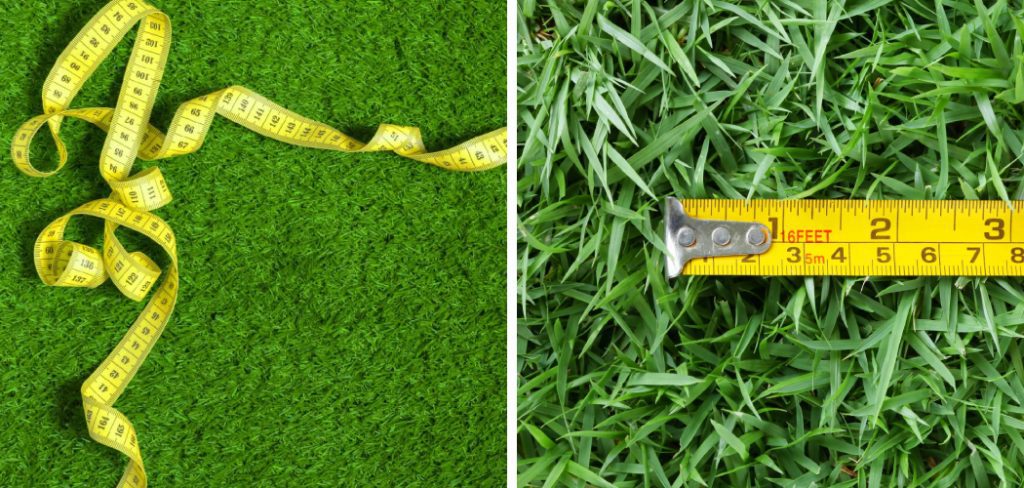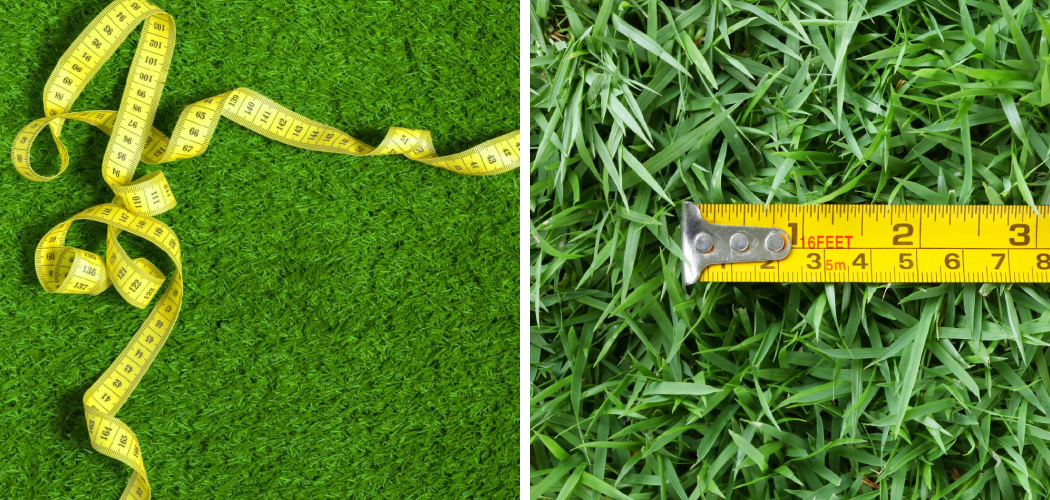To measure your lawn for fertilizer, use a measuring tape to determine its length and width, then multiply the two measurements together for the total square footage. 120 words keeping your lawn lush and green requires proper care, and fertilizing is an essential part of that process.
However, knowing how much fertilizer to use can be challenging if you don’t have an accurate measurement of your lawn. By measuring your lawn’s dimensions, you can determine the correct amount of fertilizer needed to ensure its health and vitality.
To measure accurately, use a measuring tape to determine the length and width of your lawn. Once you have these measurements, simply multiply them together to calculate the total square footage of your lawn. Armed with this information, you can confidently apply the right amount of fertilizer for optimal results.

How to Measure Your Lawn for Fertilizer: Step by Step Guide
Choosing The Right Fertilizer For Your Lawn
Choosing the right fertilizer for your lawn is crucial in maintaining its health and appearance. There are several factors to consider when selecting fertilizer. Firstly, it is important to measure your lawn accurately to determine the appropriate amount of fertilizer needed.
Secondly, understanding the specific needs of your lawn, such as its grass type, soil condition, and climate, will help you choose the correct fertilizer type. Using the wrong type of fertilizer can have a negative impact on your lawn’s health.
It may lead to nutrient deficiencies or excessive growth, resulting in weakened or damaged grass. Additionally, using the correct fertilizer type will enhance the effectiveness of its nutrients, promoting healthy growth and vibrant green color. By measuring your lawn and considering the necessary factors, you can ensure that you choose the right fertilizer for optimal lawn health.
Measuring Your Lawn Area
Measuring your lawn area accurately is crucial for determining the right amount of fertilizer to apply. To measure your lawn, you can utilize various tools and techniques such as a measuring tape or a satellite image measuring tool. Measure the length and width of your lawn to calculate the square footage.
If your lawn is irregularly shaped, break it down into smaller sections, measure each section, and add up the square footage. Accurate measurements are essential to ensure you apply the correct amount of fertilizer, preventing over- or under-application. By understanding the importance of precise lawn measurements, you can promote healthy growth and prevent nutrient deficiencies in your lawn.
Regularly measuring your lawn before fertilizer application will ensure optimal results and help maintain a lush and vibrant lawn throughout the year.
Determining Fertilizer Application Rates
Determining the right amount of fertilizer for your lawn is crucial for its health and appearance. To calculate the application rates, start by converting the square footage of your lawn into the desired unit. Different types of lawns require different fertilizer rates, so it’s important to know the recommended amounts for your specific lawn type.
By applying the correct amount of fertilizer, you can ensure that your lawn receives the necessary nutrients without causing damage or waste. So, take the time to measure your lawn accurately and follow the recommended rates to achieve a lush and vibrant lawn.
Keep in mind that proper fertilization contributes to a beautiful and healthy outdoor space.
Assessing Soil Conditions
Assessing soil conditions is crucial for determining the proper amount of fertilizer your lawn needs. Soil testing and analysis play a key role in optimizing fertilization. When testing soil, factors like ph levels, nutrient deficiencies, and organic matter content must be considered.
Interpreting soil test results is equally important to adjust fertilizer application accurately. By understanding the nutrient levels and requirements of your lawn, you can ensure the right balance of nutrients for healthy growth. Taking these steps will help you measure your lawn effectively and provide the necessary nutrients to promote vibrant and lush greenery.
Keep in mind that regular soil testing and analysis are essential for maintaining a thriving lawn throughout the year.
Understanding Fertilizer Nutrient Content
Understanding the nutrient content of fertilizers is crucial for measuring your lawn’s fertilizer needs. Reading and interpreting fertilizer labels is essential to determine the right ratio for your lawn. Different fertilizers provide varying amounts of essential nutrients, such as nitrogen, phosphorus, and potassium, which are vital for maintaining lawn health.
These nutrients promote growth, root development, and overall resilience in your grass. By carefully examining the labels, you can determine the ideal fertilizer blend for your specific lawn requirements. Whether you have sandy soil or clay soil, understanding the nutrient ratios will help optimize your lawn’s growth and ensure it receives the necessary nutrients for a lush and healthy appearance.
Regularly measuring and adjusting the fertilizer application based on nutrient content will help maintain a vibrant lawn all year round.
Applying Fertilizer Correctly
Measuring your lawn for fertilizer is crucial to ensure an effective and environmentally friendly application. Start by calculating the square footage of your lawn by multiplying its length and width. When applying fertilizer, follow the best practices to achieve optimal results.
Proper timing and frequency are essential, as fertilizers should be applied during active growing periods and not during drought or extreme heat. Avoid common mistakes such as over-application or uneven distribution. Remember to calibrate your spreader to ensure accurate coverage.
Additionally, always follow the manufacturer’s instructions regarding the type and amount of fertilizer to use. By measuring your lawn and following these guidelines, you can apply fertilizer correctly and promote a healthy, vibrant lawn without harming the environment.
Monitoring And Adjusting Fertilization Program
To ensure your lawn receives the right amount of fertilizer, it’s essential to monitor and adjust your fertilization program regularly. By regularly checking the health of your lawn, you can determine if it’s being over-fertilized or under-fertilized. Signs of over-fertilization include excessive green growth, burning or browning of the grass, and an increase in pests or diseases.
On the other hand, under-fertilization can lead to slow growth, pale or yellowing grass, and poor overall health. Based on the needs of your lawn, you can adjust the fertilizer application accordingly. This might involve reducing the amount of fertilizer if over-fertilization is detected, or increasing it if the lawn is under-fertilized.
By monitoring and adjusting your fertilization program, you can maintain a healthy and vibrant lawn throughout the year.
Frequently Asked Questions Of How To Measure Your Lawn For Fertilizer
How Do I Calculate How Much Fertilizer I Need For My Lawn?
To calculate the amount of fertilizer you need for your lawn, you should measure the area first. Determine the width and length of your lawn, then multiply these two measurements to get the total square footage. Next, check the fertilizer’s recommended application rate, usually stated on the product packaging.
Divide the total square footage by the application rate to find out how much fertilizer to use. For example, if your lawn is 1,000 square feet and the recommended application rate is 25 pounds per 1,000 square feet, you would need 25 pounds of fertilizer.
Make sure to follow the manufacturer’s instructions for proper application. Remember to wear protective gear and water your lawn after fertilizing to activate the nutrients.
How Many Square Feet Will A 50 Lb Bag Of Fertilizer Cover?
A 50 lb bag of fertilizer can cover approximately 5,000 square feet.
How Do I Measure My Lawn On Google Maps?
To measure your lawn on google maps, follow these steps: 1. Open google maps on your computer or mobile device. 2. Type your address in the search bar and press enter. 3. Locate your lawn on the map by zooming in or out.
4. Right-click on the starting point of your lawn and select “measure distance” from the drop-down menu. 5. Click on different points along the boundary of your lawn to outline its shape. 6. Each click will create a line segment, and the total distance will be displayed on the map.
7. Continue clicking until you reach the starting point, completing the loop. 8. The final distance measurement will give you an estimate of your lawn’s perimeter. 9. To calculate the area, you can draw a polygon inside the looped line.
10. The area measurement will then be displayed on the map. Follow these steps to accurately measure your lawn using google maps.
What Is The Best Way To Measure Lawn Size?
To measure the size of your lawn accurately, follow these simple steps. First, equip yourself with a measuring tape or a measuring wheel. Start at one corner of your lawn and measure the length of one side. Repeat this process for the remaining sides.
Add up all the measurements to calculate the total perimeter of your lawn. Then, measure the width of your lawn in the same manner. Multiply the length and width to find the area of your lawn. If your lawn has irregular shapes or curves, break it down into smaller sections and measure each section separately.
Add up the areas of all sections to get the total lawn size. Remember to round up your measurements to the nearest foot or meter for accuracy.
Conclusion
Measuring your lawn for fertilizer is a crucial step in maintaining a healthy and vibrant lawn. By accurately determining the size of your lawn, you can ensure that you apply the right amount of fertilizer, promoting optimal growth and reducing waste.
Whether you choose to use a measuring wheel, satellite imagery, or a simple measuring tape, the key is to be thorough and precise. Remember to take into account any irregular shapes or areas that may require different fertilizer quantities. Additionally, it is important to follow the instructions on your chosen fertilizer product, as fertilizing too much or too little can have negative effects on your lawn.
By following these steps, you can take control of your lawn care routine and enjoy a lush and beautiful lawn all year round. So get out there, measure your lawn, and give it the nourishment it needs to thrive.

